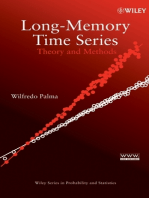0 ratings0% found this document useful (0 votes)
40 viewsNote 2
This document discusses the fundamentals of diffusion and extraction. It explains Fick's laws of diffusion, which state that the rate of diffusion is proportional to the concentration gradient across a surface (first law) and that the concentration over time is equal to the diffusion coefficient times the second derivative of the concentration with respect to distance (second law). Equations are provided for calculating flux, diffusion coefficient, and mean square displacement over time for diffusion. Diffusion combined with chemical reactions is also discussed.
Uploaded by
bananafish88Copyright
© Attribution Non-Commercial (BY-NC)
Available Formats
Download as PDF, TXT or read online on Scribd
0 ratings0% found this document useful (0 votes)
40 viewsNote 2
This document discusses the fundamentals of diffusion and extraction. It explains Fick's laws of diffusion, which state that the rate of diffusion is proportional to the concentration gradient across a surface (first law) and that the concentration over time is equal to the diffusion coefficient times the second derivative of the concentration with respect to distance (second law). Equations are provided for calculating flux, diffusion coefficient, and mean square displacement over time for diffusion. Diffusion combined with chemical reactions is also discussed.
Uploaded by
bananafish88Copyright
© Attribution Non-Commercial (BY-NC)
Available Formats
Download as PDF, TXT or read online on Scribd
You are on page 1/ 3
Part 2
Fundamentals of Diffusion and Extraction
Explanation of Diffusion: A.E. FICK (1829-1901)
Physiology research using physics.
Diffusion is a random process.
linear concentration gradient A
n (x)
n1 n 2
x 2 δx
n1> n2 n - number of molecules per volume
N1= n1Aδx # of molecules in volume 1
N2= n2Aδx # of molecules in volume 2
# of crossing in δt across the barrier
1
right to left 2 n2 Aδx
1
left to right n1 Aδx
2
rate of transfer:
dN 1 1 1
= ( n1 Aδx − n2 Aδx) ⋅
dt 2 2 δt
dN (n1 − n2 ) Aδx
=
dt 2δt
and
dn dn
n1 − n2 = − ⋅ δx ; is gradient of
dx dx concentration
P2/S2
dN (δx) 2 dn : A ·NA
= −A
dt 2δt dx NA - Avogadro’s number
dN 1 (δx) 2 dC
⋅ =− n
dt AN A 2δt dx C=
NA
J D
J - flux : number of moles per unit area per unit time
D - diffusion coefficient in m2 /s
∂C
J = −D Fick’s first law of diffusion
∂x
D = f (C )
Integral form of diffusion coefficient definition:
<x2> = 2Dt δx 2
= D⇒ x
2
= 2 Dt
2δt
where
<x2> - mean square displacement
in x direction in time t
exp. :
D = 10 −9 m 2 / s t = 10 −6 s
<x >= 2 ⋅ 10 − m x rms = 45 ⋅ 10 −9 m
2 15 2
Diffusion
Sharp Injection Output xms x
P2/S3
3 - DIMENSIONS
< r 2 >=< x 2 > + < y 2 > + < z 2 >
t
rrms = x rms ⋅ 3 = 78 ⋅10 −9 m
Second Fick’s law
∂J
J ( x) → → J ( x + dx) = J ( x) + ( )dx
∂x
∂C J ( x) − J ( x − dx) ∂J
= =−
∂t dx ∂x
from the first Fick’s law:
∂J ∂ 2C
= −D 2
∂x ∂x
therefore:
∂C ∂ 2C
=D 2
∂t ∂x
kF
Diffusion and chemical reaction: A + B C
kB
∂ CC ∂ 2 CC
=D + k F C A C B − k B CC
∂t ∂x 2
You might also like
- Transport Phenomenon Fick'S Law of Diffusion Atp-Powered Pumps - IINo ratings yetTransport Phenomenon Fick'S Law of Diffusion Atp-Powered Pumps - II23 pages
- Fick's Law of Diffusion - Overview, Formula and ApplicationNo ratings yetFick's Law of Diffusion - Overview, Formula and Application2 pages
- Diffusion: By: Dina Rahmawanty, M.Farm - AptNo ratings yetDiffusion: By: Dina Rahmawanty, M.Farm - Apt25 pages
- CHEE 4704 - Chapter 1 - Fundamentals of Mass TransferNo ratings yetCHEE 4704 - Chapter 1 - Fundamentals of Mass Transfer75 pages
- 4. IPPP-II (Diffusion and Dissolution)v3 PDFNo ratings yet4. IPPP-II (Diffusion and Dissolution)v3 PDF72 pages
- Diffusion Coefficient & Molecular Motion in LiquidsNo ratings yetDiffusion Coefficient & Molecular Motion in Liquids3 pages
- Three Fundamental Transfer Processes: Momentum Transfer Heat TransferNo ratings yetThree Fundamental Transfer Processes: Momentum Transfer Heat Transfer13 pages
- Diffusion Phenomena, Drug Release and Dissolution: Aseel SamaroNo ratings yetDiffusion Phenomena, Drug Release and Dissolution: Aseel Samaro62 pages
- Tyrrell, H. J. V. J. Chem. Educ. 1964, 41, 397-400No ratings yetTyrrell, H. J. V. J. Chem. Educ. 1964, 41, 397-4004 pages
- The Origin and Present Status of Fick's Diffusion LawNo ratings yetThe Origin and Present Status of Fick's Diffusion Law4 pages
- Lecture 5: Diffusion Coefficient (Diffusivity) : LN LNNo ratings yetLecture 5: Diffusion Coefficient (Diffusivity) : LN LN6 pages
- Equilibrium Staged Operations - SummaryNo ratings yetEquilibrium Staged Operations - Summary15 pages
- Probabilidad y Estadistica para Ingenieria y Ciencias - Devore 7thNo ratings yetProbabilidad y Estadistica para Ingenieria y Ciencias - Devore 7th16 pages
- Brownian Particle and Mean Squared Displacement HistoryNo ratings yetBrownian Particle and Mean Squared Displacement History2 pages
- 10+2 Level Mathematics For All Exams GMAT, GRE, CAT, SAT, ACT, IIT JEE, WBJEE, ISI, CMI, RMO, INMO, KVPY Etc.From Everand10+2 Level Mathematics For All Exams GMAT, GRE, CAT, SAT, ACT, IIT JEE, WBJEE, ISI, CMI, RMO, INMO, KVPY Etc.No ratings yet
- MSE 227 Homework Answers Chapter 6 - DiffusionNo ratings yetMSE 227 Homework Answers Chapter 6 - Diffusion4 pages
- Download full Understanding Voltammetry Simulation Of Electrode Processes 2nd Edition Richard G Compton ebook all chapters100% (6)Download full Understanding Voltammetry Simulation Of Electrode Processes 2nd Edition Richard G Compton ebook all chapters65 pages
- Physics for the Life Sciencesn 3rd Edition Allmang Test Bankinstant download100% (1)Physics for the Life Sciencesn 3rd Edition Allmang Test Bankinstant download32 pages
- RVR&JC College of Engineering (A), Guntur Department of Chemical EngineeringNo ratings yetRVR&JC College of Engineering (A), Guntur Department of Chemical Engineering8 pages
- Simulation of The Industrial Fixed Bed Catalytic RNo ratings yetSimulation of The Industrial Fixed Bed Catalytic R6 pages
- Polarography: Electro - Analytical TechniqueNo ratings yetPolarography: Electro - Analytical Technique67 pages
- Presentation 2 Physical Properties of SeawaterNo ratings yetPresentation 2 Physical Properties of Seawater126 pages
- Coffee Brewing: Wetting, Hydrolysis & Extraction Revisited100% (1)Coffee Brewing: Wetting, Hydrolysis & Extraction Revisited8 pages
- CCB231_Lecture 7_Principles of Solidification_Oct 2021No ratings yetCCB231_Lecture 7_Principles of Solidification_Oct 202126 pages
- Fundamentals of Heat and Mass Transfer 6th Edition-901-1000-51-100No ratings yetFundamentals of Heat and Mass Transfer 6th Edition-901-1000-51-10050 pages






















































































